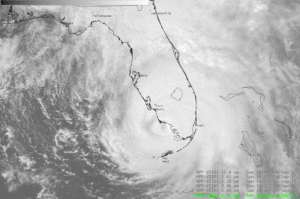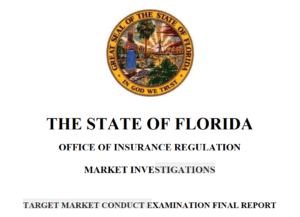One Word: Trust
Over![]() these last couple of weeks, as Florida watched the primary election unfold and I traveled the state working with various candidates, I kept hearing volunteers and voters talk about whether or not they could trust those running for office. I reflected on what that meant and it reminded me of what I learned at an early age… and so many of you were brought up like I was.
these last couple of weeks, as Florida watched the primary election unfold and I traveled the state working with various candidates, I kept hearing volunteers and voters talk about whether or not they could trust those running for office. I reflected on what that meant and it reminded me of what I learned at an early age… and so many of you were brought up like I was.
We were taught and continue to understand that trust is based on commitments made and commitments honored. When there is clarity in a message or platform so that we know what those commitments are, and more importantly, the deliverables expected, we become more comfortable letting go of details.
Commitments made and honored help us effectively balance trust and accountability. As we head into the November general election, hold those you vote for accountable so that we trust them to deliver on commitments ̵ and don’t be afraid to be vocal when you feel you have been let down.
I welcome your thoughts over the next couple of months as we continue to see where the candidates land. One of our greatest joys here at our organization is to read what you think and the amazing things you are doing about it! Enjoy this edition and all it has to offer.
My best for a great week!
Lisa
Hurricane Florence is Coming
Keep an eye on the forecast
As Hurricane Florence approaches the U.S. East Coast, insurance interests and the state of Florida are on standby as the storm develops. The Governor’s Office releasedthis statementyesterday afternoon urging Floridians to get prepared and remain watchful as the storm and its forecast track evolve. We at Lisa Miller & Associates are here and ready to help if you need our assistance. Please stay safe!
A Glimpse at Future Demands for Long-Term Care
Everything you ever wanted to know about Florida

Credit: KatarzynaBialasiewicz
We know the baby boomers are continuing to retire at record numbers, but the AARP is looking farther down the road at those ages 85+, a population that is projected to triple in the next 30 years. This is a group that will need help with the tasks of daily living, and for whom long-term care and support will be increasingly in demand. AARP has a new reference book that will be of interest to actuarial folks and insurance companies’ strategic product planning.
AARP’s Across the States: Profiles of Long-Term Services and Supportsis in its 24thyear of publication, providing state- and national-level data with analysis. It combines thousands of data points from a large variety of sources—including some original analysis not found elsewhere—into a single volume.
Topics include: age demographics and projections; living arrangements, income, and poverty; disability rates; costs of care; private long-term care insurance; Medicaid long-term services and supports (LTSS); family caregivers; home- and community-based services (HCBS); and nursing facilities.
The Florida profile is chock full of insightful information. Seniors (those ages 65+) have comprised the largest segment of Florida’s population for the past several years. They are growing from 19.4% of the population in 2015 to a projected 25% by the year 2030. By then, one in five seniors in the U.S. will live right here. Florida has the largest population of seniors in the nation, behind California.
The population of those ages 85+ is also big in Florida – and growing – from 2.7% of the population in 2015 to a projected 3.7% in 2030. That has significant implications. The 85+ group is the most likely to need help with everyday tasks such as bathing, dressing, eating, transferring, and toileting.
Despite the large senior population, we’re ranked 49thin the country for the number of nursing homes. A third of our seniors in 2016 had a disability. Annualized private pay costs in Florida across the spectrum are all ranked and generally middle of the road – from home health care (39thmost expensive in the U.S.) to a private nursing facility room (21stmost expensive in the U.S.).
Florida is ranked 40thin the country in the number of Long-Term Care Insurance policies in effect, with 37 of every 1,000 residents aged 40+ enrolled. With the population numbers projected in this report, it’s not hard to imagine that the demand for long-term care insurance, should make it one of the thriving markets of the future.
Court Backs Insurer in ‘AOB’ Contract
Plus our take on where we go from here
 First the news, reprinted here with permission, from the News Service of Florida:
First the news, reprinted here with permission, from the News Service of Florida:
An appeals court Wednesday rejected a breach-of-contract lawsuit filed against a property insurer in a dispute about “assignment of benefits” in a water-damage claim. Assignment of benefits has been a highly controversial issue in recent years, with insurers blaming abuses for driving up litigation and costs. In assignment of benefits, homeowners in need of repairs sign over benefits to contractors, who ultimately pursue payments from insurance companies.
The St. Lucie County case decided Wednesday by a panel of the 4th District Court of Appeal stemmed from policyholders John and Liza Squitieri sustaining water damage to their home. Liza Squitieri contracted with Restoration 1 of Port St. Lucie to do cleanup work and assigned the benefits to the firm. Restoration 1 submitted a claim for $20,305 to the couple’s insurer, Ark Royal Insurance Co., according to the ruling. But the insurer refused to pay the full amount, pointing to part of the contract that required approval from the couple’s mortgage company, PNC Bank, for benefits to be assigned to the contractor.
Restoration 1 sued the insurer for breach of contract, but a circuit judge dismissed the case. Restoration 1 appealed and said the restriction on assignment of benefits was illegal. In another case, the 5th District Court of Appeal last year found that an insurer could not impose such as restriction.
But Wednesday’s ruling by the 4th District Court of Appeal upheld the provision in the Ark Royal Insurance contract, saying “it is impossible to brand the contested provision as superfluous — as both of the insureds, as well as the mortgagee (PNC), have a vested interest that a reputable, legitimate third-party contractor perform repairs” on the home. “The contract here does not prohibit assignment — it imposes a condition, requiring the approval of all insureds and the mortgagee,” said the six-page ruling, written by appeals-court Judge Alan Forst and joined by judges Martha Warner and Melanie May.
Now our take. This 4th DCA rulingis actually the second time a Florida District Court of Appeal has recently ruled in favor of an insurer on this subject. (To refresh memories, the 2ndDCA ruled in favor of the insurer in Bio Logic, Inc. vs. ASI Preferred Insurance Corpfrom last October; the 5thDCA ruling referenced in the story above was in favor of OIR in Security First Insurance Co. vs. Florida Office of Insurance Regulation (OIR); and now this one in favor of the insurer.)
We asked the Florida Office of Insurance Regulation (OIR) for its opinion on this most recent ruling and they told us they are reviewing it. We also asked what standard OIR uses for such form language when we now have further different District Courts of Appeal ruling differently on treatment of AOB policy language. They said they’ll get back to us on that.
The last time we reported on this matter (OIR Poised to Eliminate AOB Language Protections from Policiesin January) OIR acknowledged different form language exists among different companies, saying that “When the Office receives the mandate from the 5th DCA, we will take the appropriate action with other companies.” So we’ve also asked OIR what mandate, if any, it received from the 5thDCA. And what action did OIR take against the other six insurance companies that have such language in their policies? They said they’ll get back to us on those questions, too.
At its semi-annual Summitcoming up next month, OIR has scheduled a session on “Regulatory Approaches to Addressing the AOB Crisis” that we’re certainly looking forward to attending. Will the ongoing conflict of court decisions prompt a review by the state Supreme Court? Will it prompt the 2019 Florida Legislature to clarify state law? Will OIR retroactively disapprove any policy form with this? We’ll continue to ask the questions and report on any developments!
Sentencing in South Florida PIP Fraud Ring
While roofers export their Florida fraud to Connecticut
 Like a perverse game of whack-a-mole, when one insurance fraudster is caught another one (or three or four) always seem to pop up, or simply move to another state. This past week saw the sentencing of two roofers who’d previously cheated almost 100 Tampa Bay area homeowners and the sentencing of a South Florida personal injury lawyer who was part of an extensive insurance fraud scheme but managed to avoid prison – even though his plea agreement called for it.
Like a perverse game of whack-a-mole, when one insurance fraudster is caught another one (or three or four) always seem to pop up, or simply move to another state. This past week saw the sentencing of two roofers who’d previously cheated almost 100 Tampa Bay area homeowners and the sentencing of a South Florida personal injury lawyer who was part of an extensive insurance fraud scheme but managed to avoid prison – even though his plea agreement called for it.
Carlton DeWayne Dunko and Frank Martin Pureber, both of Tampa, have just begun serving a one-year sentence in Connecticut for larceny. Their company there, CTST Construction, was modeled after their now defunct Florida firm, NBRC Construction of Tampa. The pair served two years in a Florida prison and are still on probation here, after collecting at least $632,000 from insurance companies on behalf of the homeowners and either failing to perform the work or stiffing subcontractors who did the work. They still face trial in Missouri for alleged fraud.
Meanwhile, on the other side of the state, another personal injury lawyer has been sentenced for his role in an insurance fraud ring involving Personal Injury Protection (PIP) claims from automobile accidents.
Steven Slootsky was one of six lawyers charged with paying tow truck drivers and auto repair shops to solicit accident victims and then in cahoots with two medical practices – Margate Physicians and Broward Spine Associates in Plantation – making fraudulent PIP claims on behalf of the victims. Five tow truck drivers and auto repairers were also busted as part of the scheme, which included various counts of patient brokering, organized crime to defraud, solicitation, and conspiracy. At the time, officials say the group received more than $521,000.
In late August, Slootsky was sentenced in Broward Circuit Court to 10 years probation on one count and five years probation, to be served concurrently, on 14 other counts, plus $170,000 in restitution to 11 insurance companies. Although his plea agreement from last fall also included up to five years in prison, he received no prison time. His attorney was quoted in published reports as saying it was “appropriate… considering the status of the case and the need to make prompt and full restitution.” Slootsky had cooperated with investigators.
He’ll also be able to seek readmission to the Florida bar in 10 years, surely not coincidentally corresponding to his 10 year probation sentence. The Florida Supreme Court granted a disciplinary revocation earlier this year, saving Slootsky from a full and permanent disbarment. So even when they plead guilty, the lawyers always seem to win.
Hurricane Irma One Year Later
Florida still recovering
 As we enter the peak six weeks of hurricane season, it was one year ago today that Hurricane Irma made landfall on the Florida Keys. The Category 4 hurricanecaused $23 billion in insured losses ̶ the sixth highest in U.S. history ̶ and $55 billion in total economic loss in Florida and other states. Yet a year later, the people and businesses of the Keys are still on the road to full recovery.
As we enter the peak six weeks of hurricane season, it was one year ago today that Hurricane Irma made landfall on the Florida Keys. The Category 4 hurricanecaused $23 billion in insured losses ̶ the sixth highest in U.S. history ̶ and $55 billion in total economic loss in Florida and other states. Yet a year later, the people and businesses of the Keys are still on the road to full recovery.
The Florida Office of Insurance Regulation’s (OIR) mid-August figures show total estimated insured losses here to date of $10.5 billion (up from May’s report of $9.7 billion). The number of claims is now 997,237 (up from 988,000) and so are definitely leveling off. 92% of claims are closed, with a 2:1 ratio of paid to unpaid closed claims.
But the hidden story – and damage – from Irma was flooding. Various data providers estimate the storm surge damage from Irma at $29 billion to $46 billion for both residential and commercial properties. Included in the OIR figures are private flood insurance claims, which numbered just a bit more than 1,800, but OIR doesn’t provide the insured loss figure. Then there is the National Flood Insurance Program (NFIP), which according toFEMA, had 28,500 claims submitted as of August 1, with about $964 million paid out to policyholders. The average payment is about $52,000.
So that still leaves a whole lot of Florida flood damage unaccounted for – and uninsured – given that most homeowners policies don’t cover flooding. FEMA estimates that only 46% of Florida homeowners in high risk flood zones have NFIP insurance. Then there are those living outside of formal flood zones, some of whom had inland flooding and also had to pay for damages out of their own pockets.
The NFIP payouts are part of more than $3 billion in FEMA disaster assistance to Florida for recovery and rebuilding, which includes low-interest U.S. Small Business Administration disaster loans. Another $1.3 billion from FEMA went to help survivors with temporary housing, rental assistance, interim home repairs, and other essential needs, along with $210 million to similarly reimburse local and state governments.
On the Florida Keys, where tourism is king, recovery is steady but ongoing. All 10 state parks are open for day use. Hawks Cay Resort on Duck Key just formally reopened after a $50 million repair project. The 177 rooms brings the Keys’ lodging inventory up to 90% of what it was pre-Irma. The silver lining in a hurricane’s destruction is the better construction and improved look that rebuilding brings. The resort has completely renovated rooms, two new restaurants, a new oceanfront pool, and other enhancements. Two-hundred people were hired to replace those originally laid-off. Affordable housing continues to be built.
Nearly all resorts that were closed by Irma are expected to be open by January. On top of that, new hotels are being built. The Keys’ first all-inclusive adults-only resort is scheduled to open in December in Key Largo. Increased air service is coming, too, with United Airlines announcing it is increasing its daily flights from Newark from seasonal to year-round with increased service from Chicago as well.
Top 10 Market Conduct Exam Issues
Untimely action on claims is most common mistake
 Wolters Kluwer Financial Services is out with its 14thannual report of the Top 10 violations found in a review of last year’s P&C market conduct examinations across the country. As the saying goes “Learn all you can from the mistakes of others, for you won’t have time to make them all yourself.” These are the most common reasons property and casualty insurers are found to be out of compliance:
Wolters Kluwer Financial Services is out with its 14thannual report of the Top 10 violations found in a review of last year’s P&C market conduct examinations across the country. As the saying goes “Learn all you can from the mistakes of others, for you won’t have time to make them all yourself.” These are the most common reasons property and casualty insurers are found to be out of compliance:
-
- Failure to acknowledge, pay, investigate, or deny claims within specified timeframes
- Failure to cancel, non-renew, renew policies in accordance with requirements
- Failure to issue correct payments and/or compliant denial notices
- Failure to provide required compliant disclosures in claims processing
- Using unapproved/unfiled rates/rules or misapplying rating factors
- Failure to process total loss claims properly
- Failure to adhere to producer appointment, termination, records and/or licensing requirements
- Improper/incomplete documentation of underwriting files
- Failure to provide required compliant disclosures in the underwriting processes
- Improper/incomplete documentation of claims files
Wolters Kluwer is offering a copy of its report, as well as a recording of its recent webinar on the subject via this email link.
The Florida Office of Insurance Regulation (OIR) is holding its semi-annual Summit next month which includes sessions on this very subject, including common filing mistakes and the basics of effective form filing.
Revising Florida’s State Constitution
Amendment 1 would add an additional $25,000 homestead exemption; merry-go-round court battles continue on other amendments
 (Editor’s note: This is part of an ongoing series on the now 12 proposed state constitutional amendments that will appear on this November’s ballot for Florida voters to consider.)
(Editor’s note: This is part of an ongoing series on the now 12 proposed state constitutional amendments that will appear on this November’s ballot for Florida voters to consider.)
The Florida Supreme Court has struck one proposed constitutional amendment from the ballot this November but allowed three others to remain in place. The justices, by a 4-3 vote, struck Amendment 8, which was actually three proposals in one amendment. The amendment would establish term limits on local school board members; allow the state to approve and supervise charter schools in place of local school districts; and require civic literacy education in public schools.
Its opponents argued the true purpose of the amendment – to allow the state and not local school board to control charter schools – was obscured. The high court upheld a Leon County circuit court ruling that found the measure was misleading because it failed to inform voters of the “chief purpose and effect” of the proposal.
The Supreme Court rejected challenges to remove three other amendments from the ballot. Amendment 6creates new rights for crime victims, requires administrative law judges interpret state statutes and rules, and increases the retirement age to 75 for judges; Amendment 10requires local governments elect all their constitutional officers, among other measures; and Amendment 13 eliminates greyhound dog racing by the year 2020.
Also this past week, three other proposed amendments were struck from the ballot for now by a Leon County Circuit Court. Amendment 7, which changes University and State College systems’ governance, while providing scholarships to survivors of first responders and military members; Amendment 9, which prohibits both offshore drilling and vaping in indoor workplaces; and Amendment 11, which makes changes to property rights, obsolete sections of the Constitution, and criminal statutes. Judge Karen Gievers ruled all three were “unconstitutionally bundled,” with multiple measures in each amendment. The ruling is under appeal and will likely end up in the state Supreme Court for an ultimate ruling.
Now on to today’s lesson. Amendment 1is one of the few single subject amendments on this November’s ballot and one of three that the Florida legislature placed there. It is not facing a court challenge.
The amendment would increase the homestead exemption from its current $50,000 to $75,000 on all levies (taxes) except local school taxes and apply only to homes with at least $125,000 in value.
If passed this would be the third increase in the homestead exemption, which is a tax break on Floridians’ primary residencies. Currently, there is a $25,000 exemption on the assessed value of such properties between $50,000 and $75,000 and another $25,000 exemption on the assessed value of properties between $75,000 and $100,000. Amendment 1 would add another $25,000 exemption on assessed value between $100,000 and $125,000. It and the previous exemption apply to all taxes other than local school district taxes.
So if you have a homesteaded property in Florida with a current assessed value of at least $125,000, you would be paying taxes instead based on a valuation $75,000 below that, if this amendment passes. Your local school district tax, however, would continue to be based on a taxable valuation just $25,000 below your assessed value. This and previous legislatures designed it that way to preserve local school funding.
For more information, you can always check out the LMA Backgrounder – Florida’s 12 Proposed Constitutional Amendments on the November 2018 Ballot, available on our website.
Florida Ranks #1 in Growth of Women-Owned Businesses
While women CEOs in traditional businesses face troubling disadvantages
 Florida women entrepreneurs are getting top billing in a new report with insurance marketing implications that shows they have started their own businesses at a faster pace than women in any other state over the past 11 years. Nationally, the share of women-owned businesses has grown from 29% in 2007 to 40% in 2018. The numbers have gotten even better in just the past year, with an average of 1,821 new women-owned firms created every day.
Florida women entrepreneurs are getting top billing in a new report with insurance marketing implications that shows they have started their own businesses at a faster pace than women in any other state over the past 11 years. Nationally, the share of women-owned businesses has grown from 29% in 2007 to 40% in 2018. The numbers have gotten even better in just the past year, with an average of 1,821 new women-owned firms created every day.
The 2018 State of Women-Owned Businesses Report,commissioned by American Express, also shows the Miami metropolitan area is fifth ranked in the nation for economic clout – a measure that includes the growth in the number of women-owned firms, employment and revenues.
“This new data demonstrates not only the remarkable impact women entrepreneurs have on our economy when it comes to creating jobs and generating revenue, but also the growing role of women-owned businesses in our communities,” said Julie Tomich, Senior Vice President for American Express Global Commercial Services, in a release. “Over the past 11 years, we’ve seen women’s entrepreneurship and economic impact increase – especially among the growing number of women-owned companies that generate more than $1 million in revenue.”
Other states following Florida’s #1 ranking for growth of women-owned firms are Georgia, Michigan, and Tennessee and South Carolina, which tied.
While the number of women-owned businesses in the U.S. grew 58% from 2007 to 2018, firms owned by women of color grew at nearly three times that rate (163%). As of 2018, women of color account for 47% of all women-owned firms.
There are lessons here for the insurance industry which should take heed of this trend as we contemplate new marketing approaches and products for women-owned businesses and other emerging markets.
The news is not all good for working women though. A new Florida State University research study has found women CEOs in the U.S. are paid less, have shorter tenures, and their companies are punished in the stock market, even when their firms are just as profitable as those run by men. They are also less likely to serve as board chairs and they have a much tougher time attaining CEO status because of significantly less demand for their leadership compared to men.
“This research should be eye-opening to people, and I hope they take a closer look,” said Michael Holmes, FSU’s Jim Moran Associate Professor of Strategic Management, in a release. “We hope this sets the record straight on past research, some of which has produced conflicting results, and now people can build on this aggregation of findings.”
The FSU research was published in the journal Organizational Behavior and Human Decision Processes.
It’s no wonder more women are starting their own businesses!
Share Your Home, Share Your Heart

Credit: Rawpixel
We started this newsletter with an updated data source for you on Florida’s long-term care market and as we were going to press on the newsletter, we have another gem that just came across our desk that will be of special interest to those who work in the workers’ compensation space. It’s the 2018 Construction Industry Summary, published by the Florida Department of Financial Services Division of Workers’ Comp. It is an incredible data summary report of trends and the unique aspects of the Florida’s workers’ comp system. This is the first of a series released by DFS and we appreciate them making this data transparent in such an easy to retrieve format.
There is no doubt that good data begets good policy. Take that and create an innovation that addresses two problems in one swoop – in this next case, a housing shortage and human loneliness – and you’re really onto something. For most of us, it was the television series The Golden Girlsthat introduced us to the concept of home sharing (in a hilarious way). But the folks in Sarasota are using the concept to tackle some serious problems.
In the midst of a housing shortage, Southwest Florida is home to a higher-than-normal share of empty bedrooms. Every third house, apartment or condo in Sarasota County has just one person living inside. In almost 60% of these households, the single occupant is 65 or older. The Sarasota Herald-Tribune has done an excellent, heartfelt piece on a pilot project to encourage home sharing in Sarasota. It’s worth the read!
Here’s hoping that your week is full of innovation and creativity!
Lisa

